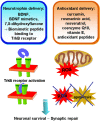Dual and multi-drug delivery nanoparticles towards neuronal survival and synaptic repair
- PMID: 28761415
- PMCID: PMC5514857
- DOI: 10.4103/1673-5374.208546
Dual and multi-drug delivery nanoparticles towards neuronal survival and synaptic repair
Abstract
Among the macromolecular drug targets in neurodegenerative disorders, the neurotrophin brain-derived neurotrophic factor (BDNF) and its high-affinity tropomyosin-related kinase receptor (TrkB) present strong interest for nanomedicine development aiming at neuronal and synaptic repair. Currently, BDNF is regarded as the neurotrophic factor of highest therapeutic significance. However, BDNF has delivery problems as a protein drug. The enhanced activation of the transcription factor CREB (cAMP response element-binding protein) has been evidenced to increase the BDNF gene expression and hence the production of endogenous BDNF. We assume that BDNF delivery by nanocarriers and mitochondrial protection may provide high potential for therapeutic amelioration of the neuroregenerative strategies. Beneficial therapeutic outcomes may be expected for synergistic dual or multi-drug action aiming at (i) neurotrophic protein regulation in the central and peripheral nervous systems, and (ii) diminishment of the production of reactive oxygen species (ROS) and the oxidative damage in mitochondria. Our research strategy is based on a nanoarchitectonics approach for the design of nanomedicine assemblies by hierarchical self-assembly. We explore nanoarchitectonics concepts in soft-matter nanotechnology towards preparation of biodegradable self-assembled lipid nanostructures for safe neuro-therapeutic applications of multi-target nanomedicines.
Keywords: BDNF delivery; CREB; combination therapy; macromolecular drugs; nanomedicine; neuroprotective lipid nanocarriers; neurotrophic factor.
Conflict of interest statement
Conflicts of interest: None declared.
Figures


Similar articles
-
In Vitro Modulation of TrkB Receptor Signaling upon Sequential Delivery of Curcumin-DHA Loaded Carriers Towards Promoting Neuronal Survival.Pharm Res. 2017 Feb;34(2):492-505. doi: 10.1007/s11095-016-2080-4. Epub 2016 Dec 19. Pharm Res. 2017. PMID: 27995523
-
Self-Assembled Nanoscale Materials for Neuronal Regeneration: A Focus on BDNF Protein and Nucleic Acid Biotherapeutic Delivery.Nanomaterials (Basel). 2022 Jun 30;12(13):2267. doi: 10.3390/nano12132267. Nanomaterials (Basel). 2022. PMID: 35808102 Free PMC article. Review.
-
BDNF-induced local protein synthesis and synaptic plasticity.Neuropharmacology. 2014 Jan;76 Pt C:639-56. doi: 10.1016/j.neuropharm.2013.04.005. Epub 2013 Apr 16. Neuropharmacology. 2014. PMID: 23602987 Review.
-
Icariside II, a Phosphodiesterase-5 Inhibitor, Attenuates Beta-Amyloid-Induced Cognitive Deficits via BDNF/TrkB/CREB Signaling.Cell Physiol Biochem. 2018;49(3):985. doi: 10.1159/000493232. Epub 2018 Sep 7. Cell Physiol Biochem. 2018. PMID: 30196289
-
Brain-derived neurotrophic factor and trkB signaling in parasympathetic neurons: relevance to regulating alpha7-containing nicotinic receptors and synaptic function.J Neurosci. 2004 May 5;24(18):4340-50. doi: 10.1523/JNEUROSCI.0055-04.2004. J Neurosci. 2004. PMID: 15128848 Free PMC article.
Cited by
-
Cubic Liquid Crystalline Nanostructures Involving Catalase and Curcumin: BioSAXS Study and Catalase Peroxidatic Function after Cubosomal Nanoparticle Treatment of Differentiated SH-SY5Y Cells.Molecules. 2019 Aug 22;24(17):3058. doi: 10.3390/molecules24173058. Molecules. 2019. PMID: 31443533 Free PMC article.
-
Ferulic Acid-NLC with Lavandula Essential Oil: A Possible Strategy for Wound-Healing?Nanomaterials (Basel). 2020 May 8;10(5):898. doi: 10.3390/nano10050898. Nanomaterials (Basel). 2020. PMID: 32397093 Free PMC article.
-
Nanoparticles for Lymph Node-Directed Delivery.Pharmaceutics. 2023 Feb 8;15(2):565. doi: 10.3390/pharmaceutics15020565. Pharmaceutics. 2023. PMID: 36839887 Free PMC article. Review.
-
Synergistic Phototherapy-Molecular Targeted Therapy Combined with Tumor Exosome Nanoparticles for Oral Squamous Cell Carcinoma Treatment.Pharmaceutics. 2023 Dec 26;16(1):33. doi: 10.3390/pharmaceutics16010033. Pharmaceutics. 2023. PMID: 38258044 Free PMC article.
-
AAV-Syn-BDNF-EGFP Virus Construct Exerts Neuroprotective Action on the Hippocampal Neural Network during Hypoxia In Vitro.Int J Mol Sci. 2018 Aug 5;19(8):2295. doi: 10.3390/ijms19082295. Int J Mol Sci. 2018. PMID: 30081596 Free PMC article.
References
-
- Angelov B, Angelova A, Drechsler M, Garamus VM, Mutafchieva R, Lesieur S. Identification of large channels in cationic PEGylated cubosome nanoparticles by synchrotron radiation SAXS and Cryo-TEM imaging. Soft Matter. 2015;11:3686–3692. - PubMed
-
- Angelov B, Angelova A, Filippov SK, Drechsler M, Štěpánek P, Lesieur S. Multicompartment lipid cubic nanoparticles with high protein upload: Millisecond dynamics of formation. ACS Nano. 2014;8:5216–5226. - PubMed
-
- Angelov B, Garamus VM, Drechsler M, Angelova A. Structural analysis of nanoparticulate carriers for encapsulation of macromolecular drugs. J Mol Liq. 2017;235:83–89.
-
- Angelova A, Angelov B, Drechsler M, Lesieur S. Neurotrophin delivery using nanotechnology. Drug Discovery Today. 2013;18:1263–1271. - PubMed
-
- Angelova A, Angelov B, Mutafchieva R, Lesieur S. Biocompatible mesoporous and soft nanoarchitectures. J Inorg Organomet Polym. 2015;25:214–232.
Publication types
LinkOut - more resources
Full Text Sources
Other Literature Sources

